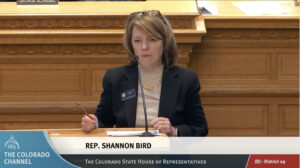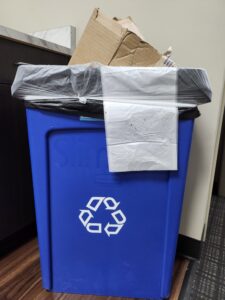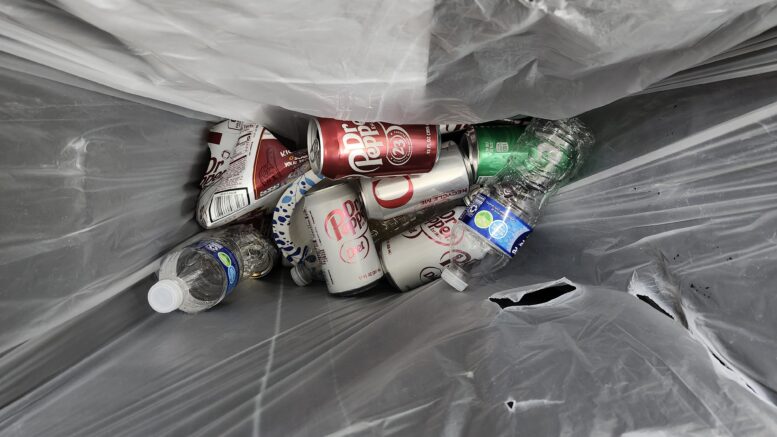The long-anticipated price tag for Colorado to establish a statewide recycling system is in — as much as $310 million to implement a recommended “medium” option among three choices, all to be paid by consumer-product manufacturers who use paper and packaging.
A team of officials from the Colorado Department of Public Health and Environment and the industry-led Circular Action Alliance unveiled its report and preferred choice of program on Tuesday to the Joint Budget Committee. The JBC must determine quickly whether to proceed with the recommended program plan or to return it to the Legislature for further consideration and potential delay in implementation of the plan.
Gov. Jared Polis signed a law in 2022 creating an extended producer responsibility program into which sellers of packaged goods would pay fees based on the amount of packaging they use in order to launch a statewide recycling system. While observers agree Colorado’s recycling rate is poor, with only 22% to 28% of recyclable goods diverted from landfills, the method for setting up a statewide system came under significant criticism from business groups that questioned its costs and constitutionality.
The Circular Action Alliance — a national nonprofit organization of producers led by companies such as Keurig Dr Pepper, General Mills and Amazon — hired engineering firm HDR and consulting company Eunomia to assess the state’s current recycling landscape and the costs of growing it. Early this month, the firms submitted a report listing low, medium and high scenarios that could implement different levels of statewide service for varying costs, and this week it recommended the moderate approach of the trio.
How the recycling system could work
Under that system, households along the Front Range, where most of the population lives and most of the state’s recycling materials recovery facilities lie, would receive weekly recycling service, an upgrade from the biweekly service that’s common now. The other regions of the state would receive biweekly service, and officials would expand drop-off sites in all regions, in addition to paying for advanced technology upgrades at recycling facilities and funding those facilities’ capacity growth.
Authors of the Colorado needs assessment estimated such a system would cost between $160 million and $260 million to launch and keep operational by 2030 and between $190 million and $310 million by 2035. That investment would boost recycling rates to 38% to 44% by 2030 and 52% to 58% by 2035, increasing the 310,000 annual tons of currently recycled material to as much as 720,000 tons in 11 years.
JBC members, who are supposed to provide guidance by the end of this week, did not comment specifically on the recommendation, which comes shortly after Polis rolled out an update to the state’s greenhouse-gas emissions reduction roadmap. But chairwoman Rep. Shannon Bird, D-Westminster, acknowledged the high-cost, high-reward proposition could be significant.
“Colorado really does have a unique opportunity to improve recycling, as you have shown us here,” Bird said.

Colorado state Rep. Shannon Bird speaks on the House floor during the 2023 legislative session.
Business and trade groups push back
But the Colorado Consumer Coalition — an organization of trade associations, businesses, and individuals who are concerned about the proposed program’s impact on consumers — questioned both the proposed cost and the assumed outcome of such a pricey plan. The hoped-for recycling boost has not borne out in Canadian provinces launching similar programs, and even reaching that goal would mean businesses paying a nine-figure sum to recycle just 720,000 metric tons of Colorado’s 7.1 million metric tons of annual waste, executive director Jaime Gardner said.
“This program, as presented, will cost upwards of $310 million per year, fees that will inevitably be passed on to Colorado consumers at a time when inflation has made grocery runs a painful experience for most families,” Gardner said in a statement on Tuesday. “Our members hope that the members of the JBC continue to ask the tough questions as they follow up on today’s presentation, and it is our opinion that they should send it back to the Legislature for the critical review it needs.”
Under the 2022 law, producers of paper and packaging will fund the recycling program. The CAA, the designated producer responsibility organization, will determine the fees needed to raise proper revenues and will oversee implementation and compliance, while CDPHE will regulate this new system.
Why backers support the recycling plan
The extended-producer responsibility system is meant to provide equitable access to recycling for all Coloradans at a time when curbside recycling is not available to many urban residents of multifamily housing and is accessible to just 20% of rural residents. When the program begins in 2026, the needs assessment estimated, 500,000 more households will receive curbside recycling in municipalities and another 100,000 to 200,000 households will receive service in rural and other areas.

A recycling bin
Analysts concluded that when collection occurs more frequently, as it would under the program, recycling rates will rise. Recycling facilities will require between $85 million and $100 million in upgrades to handle the additional capacity of materials — a cost that would be funded by per-item fees.
Another goal of the law is to create end markets for recycled and sorted material that could be sold to manufacturers that would bring used items back to life as new goods. Right now, glass is the only collected material with a Colorado end market — three plants that turn the substance into new glass containers — and there are no paper mills in the state, no local markets for aluminum and no mills that accept steel or tin cans.
A number of potential benefits
The “medium” scenario would provide for collection of most packaging types, from paper boxes to aluminum containers to glass, by 2030. One exception would be flexible plastics, which would be collected only by drop-off beginning in 2035.
Launching such a program would hold environmental benefits for the state as factories would be required to produce less new material and landfills would emit less methane gas, explained Wolfgang Kray, the materials management unit leader for CDPHE. Roughly 1.3 million metric tons of material could be diverted from dumps to recycling centers by 2035, lessening greenhouse-gas emissions equivalent to the removal of 278,000 passenger vehicles from the road.
But the program could also bring an economic boost to a state that Randy Moorman, director of community campaigns at Eco-Cycle, cited during a 2022 news conference as boasting 86,000 jobs and $8.6 billion in annual economic benefit in the recycling sector. Based on U.S. Environmental Protection Agency studies showing that every 1,000 tons of recycled goods creates $65,000 in wages, the program could generate about 70,000 new jobs and $31 million in annual wages, Kray said.
Potential drawbacks too
Officials recommended the medium scenario over a low scenario that would provide for just biweekly recycling service and may not get more than 50% of recyclable materials diverted and over a high scenario that would achieve maximum diversion of 60% at a much higher price tag.
But even with all the potential boosts that state officials described, a number of significant questions remain about the program.
The law serves as an end-around on the Taxpayer’s Bill of Rights by assigning governmental duties such as the collection of mandatory fees for a state-overseen recycling system to a nonprofit that will fall outside of state revenue limits, critics said in 2022. Several opponents warned at the time that a lawsuit challenging the constitutionality of the program is all but guaranteed, though such a lawsuit is unlikely to be filed before the program is up and running and packaging producers can prove harm.
Also, the “rushed” process requires all producers that could pay fees to register with the Circular Action Alliance by July 1 but does not explain how the producer responsibility organization will contact all of them and get them signed up by then, Gardner said.
